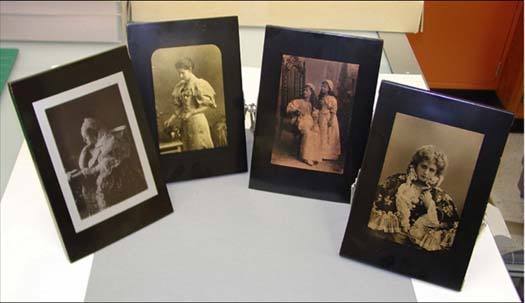
Topics in Photographic Preservation 2005, Volume 11, Article 7 (pp. 57-72)
Presented at the 2005 Winter Meeting in Vancouver, British Columbia
Four unusual photographic images in tones of copper, silver and gold, from the Gernsheim Collection of the Harry Ransom Center at the University of Texas at Austin, were the focus of an analytical investigation using digital microphotography, X-ray spectrometry and infrared analysis. Described as a “Metallic Photo Print” on labels on the back of the wooden substrates of three of the photographs studied, these labeled images also provided the British patent number under which the process was registered. The study of the patent literature together with results of analytical investigation helped to understand the process. The detailed microscopic investigation of the silver portrait of Queen Victoria also revealed a mourning bracelet containing a photograph of Prince Albert. A similar albumen print portrait of the Queen from the HRC Collection helped to provide an estimate about when the original negative for that image was taken. A study of the women's dresses and fashion accessories could be useful in dating some of the other images. The knowledge of materials used to make the Metallic Photo Prints will allow the HRC to adjust accordingly both storage and exhibition conditions of the photographs in order to help ensure their long-term preservation.
This investigation came about during the inaugural run of the Getty Conservation Institute's portable analytical lab, part of the larger GCI collaborative research project on the conservation of photographs; one goal of which is the ‘development of scientific methodologies for instrumental and analytical characterization of photographs and photographic material’.1 In late February 2003, Dusan Stulik and Herant Khanjian (Senior Scientist, and Assistant Scientist, respectively) of the Getty Conservation Institute (GCI) came to the Harry Ransom Center with their portable analytical lab — including Attenuated Total Reflectance—Fourier Transform Infrared Spectrometer (ATR-FTIR), and X-Ray Fluorescence Spectrometer (XRF) equipment —to examine and analyze examples of known photographic processes. This information was used to aid in the preparation of a database or ‘atlas of analytical signatures of different photographic processes to aid in identification of photographic materials’.2
The Photography Department of the Harry Ransom Humanities Research Center at The University of Texas at Austin grew from the core holdings formed by The Gernsheim Collection, which was purchased by then-Chancellor Harry Ransom and The University of Texas at Austin in 1963, from Helmut and Allison Gernsheim. The collection includes prints and negatives, notably some of the earliest examples, supplemented by manuscripts, archives, and memorabilia, of significant photographers of the nineteenth and twentieth centuries. The Ransom Center Photography Department also includes over 400 pieces of original photographic apparatus, and a library of 35,000 books and journals on the theory, techniques, art and history of photography.
Both significant individual pieces and large archives of contemporary work continue to be added annually.3 The scope of the collection provides a wealth of known photographic processes and materials for consideration in the collaborative research project with the Getty Conservation Institute. Within the Gernsheim Collection alone are numerous fascinating and somewhat obscure items, such as these four metallic photographic prints (fig. 1). These metallic photographic prints were included in the investigation because they appeared to present some known features, if information on the versos of two of the images (fig. 2) was any indication, and because they are intriguing images and objects in their own right.

Fig. 1. Metallic Photographic Prints. To compensate for black-and-white reproduction of the illustration, the image tonalities are listed here, left to right: M-1, silvery color; M-3, golden color; M-2, coppery color; M-4, golden color
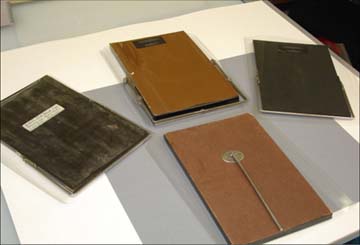
Fig. 2. Versos of the metallic photographs. Top, left to right: M-4, M-2, M-3. Bottom: M-1
The verso of M-3 has a printed label located near the top verso edge, containing the patent number (fig. 3), and exhibits a graphite or pencil inscription on the back of the wood panel that reads: [illegible.] pure gold” (fig. 4); while The verso of M-4 exhibits a white paper label with a notation hand-written in black ink indicating that the image is made of “pure gold”(fig. 5).
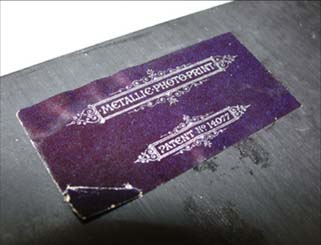
Fig. 3. Printed label on verso of M-3
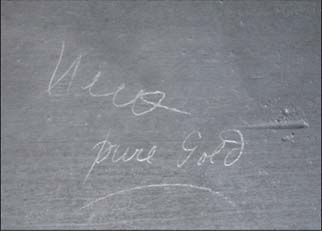
Fig. 4. Hand-written label on verso of M-3
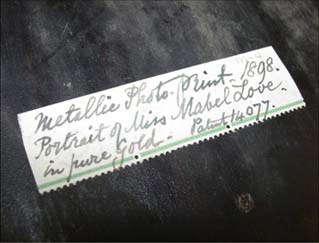
Fig. 5. Hand-written label on the verso of M-4: “Metallic Photo. Print. 1898. Portrait of Miss Mabel Love. in pure gold. Patent 14077.”
The information provided in the labels led to a literature search and the following findings. In Gernsheim's typed inventory lists (specifically, List #22) is a reference to these [f]our rare examples of this little-known invention (patent no. 14077). The portraits are on wood 9″ × 6″ [approx. 23 × 15 cm] with frame to stand up on over-mantel or piano.” Among the books and journals that came in the Gernsheim Collection were: Patents for Inventions, Fifty Years Subject Index 1861–1910, Class 98 (ii) Photographic Processes and Apparatus other than for taking Photographs; and a volume of patent abridgments, or summaries, published by the British Patent Office, for the time period from 1889–1896. In the Index, under the headings ‘Photographic processes &c.—cont., enamelling &c.—cont., enamels and other specially ornamental photographs.’ under the year [18]96, the first patent number listed is 14077. The patent summary was then located in Patents for Inventions. Abridgments of Specifications. Class 98, Photography. Period – A.D. 1889–1896., specifically the volume for 1893–1896:
14,077. Fowler, H.E. June 25.
Sensitized plates &c. and films. –Relates to a method of producing photographs in gold, silver, or other metals on polished surfaces. A plate of glass is coated with a mixture of albumen, glycerine, dextrine, syrup or honey, bichromate of potassium, and water. The coating is dried and exposed under a negative. Powdered metal is then brushed on, and the surface coated with collodion. The plate is now immersed in water so that the film can be stripped off. The surface of the panel to which the picture is to be transferred is coated with gelatine or the like; the film is placed on this surface under water and the edges dissolved away by a mixture of ether and alcohol applied along a straight edge.
Thanks to independent researcher and photohistorian Roger Taylor, a copy of the complete patent specification was obtained through the British Patent Office Archives, held at the British Library. The patent number 14,077 has the title “A Process for Producing Photographs in Gold, Silver, or other Metals on Polished Surfaces”.4 In this specification, “…Henry Edwin Fowler of 169 Malpas Road Brockley in the County of Kent Photographer… hereby declare[s] the nature of this invention and in what manner the same is to be performed, to be particularly described and ascertained in and by the following statement.”5
A summary of the statement and process follows:
A glass support slightly larger than the picture to be produced is cleaned thoroughly and then coated with the following mixture:
| Albumen | 8 drams |
| Glycerine | 40 drops |
| Dextrine | 4 drams |
| Lyles golden syrup or honey | 4 drams |
| Bi-chromate of potassium | 3 drams |
| Water | 8 ounces |
‘Or any mixture used in the dusting on process’. [Note – Dusting on process(es): In Luis Nadeau's Encyclopedia of Printing, Photographic, and Photomechanical Processes, these are also called Powder processes – referring to photographic images or reliefs made visible by dusting powder over their sticky surface.]
Summary of steps in the process:
*Note: The wood panel or surface on which the picture is to be placed is first coated with collodion or gelatine. Allow this coating to set, and then place the substrate in water under the picture. A small camel hair brush can help position the picture. As soon as the picture is in place, the article is “raise[d] gently out of the water and [stood] up to dry”.
“The edges can be trimmed by using a straight edge and wiping round with a mixture of sulphuric ether [1 1/2 parts] and alcohol [1 part]”.
The following step is not mentioned in the patent specifications, but could have been done in practice, and was included in the process as outlined here by Dr. Stulik:
The examination of the four metallic photographic prints was conducted using the instruments noted below, and the findings were compared with the information uncovered in the literature search. Only non-destructive analytical techniques were used to examine components of these photographs. Elemental analysis was carried out using a NITON XL 700 portable XRF spectrometer (figs. 6–8). Organic analysis of components was conducted using a TravelIR ATR-FTIR spectrometer, with a Dell Inspiron 4150 laptop computer, Quant ID, Omnic FT-IR software, GCI IR library of photographic processes. [For further details on the portable analytical laboratory, refer to Getty Conservation Institute portable analytical laboratory for photograph conservation: the first three years” by Dusan C. Stulik; forthcoming in the Preprints of the 14th Triennial Meeting of the ICOM Committee for Conservation, The Hague, The Netherlands, 12–16 September 2005, Vol. I., in the section under Working Group 8, Photographic Records.]
The diagrams that follow show the elemental analysis readings for the corresponding areas indicated, for each of the metallic photographic prints (fig. 9–11). Readings were taken in margin (non-image) areas, and in various mid- to maximum-(metallic) density image areas, or what could be considered mid-tone to highlight image areas.

Fig. 6. Dusan Stulik, examining one of the metallic photographic prints using the NITON XL 700 portable XRF spectrometer
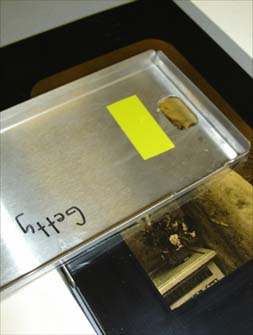
Fig. 7. Base plate for the NITON XL 700 XRF spectrometer unit, showing ‘window’ or aperture. Also note that Mylar® covers the bottom side of the base, so that it is not resting directly on the surface of the object
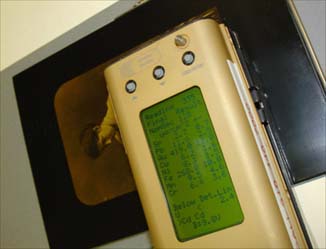
Fig. 8. This illustration is a view of the display screen on the XRF unit, showing the final readings in this area of image M-3
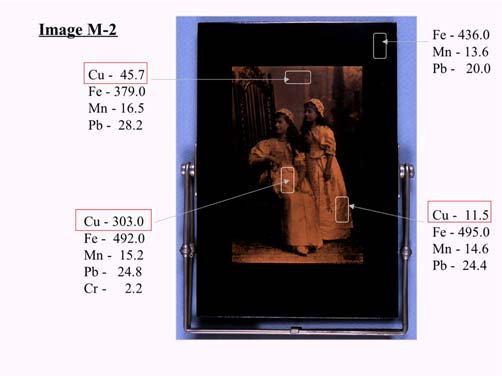
Fig. 9. Image M-2 exhibits a rich, orange-reddish tonality visually associated with metallic copper, and the material is indeed copper, as found using the XRF spectrometer
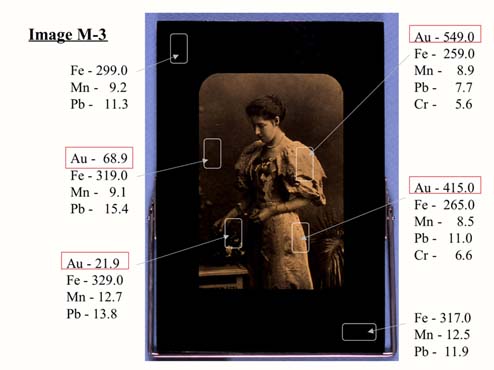
Fig. 10. Image M-3, does turn out to be made using gold, according to XRF spectrometry, corroborating the pencil notation on the verso of the object, shown in Fig. 4
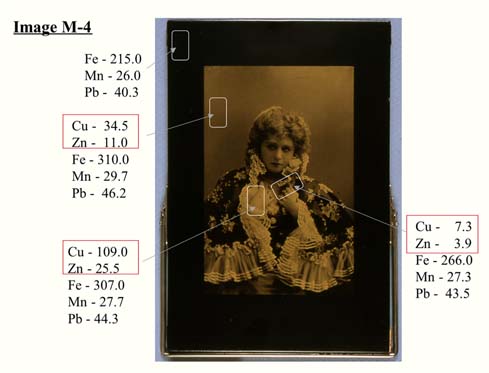
Fig. 11. Interestingly, image M-4 –although visually it resembles image M-3 in color and tonality – turns out to be composed of what was known as ‘bronze powder’ [actually brass, an alloy of copper (Cu) and zinc (Zn)]
The readings for iron (Fe) and manganese (Mn) that occur throughout each of the images and appear to be the predominant constituent elements in the margins and non-image areas of each photographic print, indicate the presence of umber pigments in the dark, black-brown layer coating the wood substrates. Umber is a brown earth pigment containing iron hydroxide [Fe(OH)3] and manganese dioxide [MnO2].6 The element oxygen, due to its low molecular weight, is not detectible via XRF analysis. The presence of lead (Pb) indicates the possible use of lead white in a priming or preparation layer between the wood substrate and the dark paint coating layer above. Sampling or destructive testing was not conducted on these objects at the time of this examination, but could be undertaken in the future to obtain information about the composition of these layers. The appearance of chromium (Cr) in some of the readings is consistent with use of bichromate in the colloid layer.
The elemental analysis of image M-2 indicated that copper is the metallic component of the final image in the mid-tone to highlight image areas. The readings obtained from M-3 and M-4, which have similar image tonalities upon visual examination, using unaided vision as well as very low magnification, presented interesting results in that they confirmed information provided on the verso of M-3, and disproved that provided on the label on M-4. Both were said to be images made in ‘pure gold’, but actually only M-3, the 3/4-length portrait of the standing woman, contains gold (Au). The other image, the portrait said to be of a Miss Mabel Love, is apparently composed of a metal alloy, a material known as bronze powder – in which the metal alloy is actually brass, a combination of copper (Cu) and zinc (Zn)). The term ‘bronze’ refers to the general range of hues and tonalities. Bronze powders had been used for decades, from approximately the 1850s into the late 1890s, in gilded types of decoration.7
The image of Her Royal Highness Queen Victoria, in M-1, is particularly interesting in a number of ways. It is the only one of the four images that is of a clearly identifiable person8, a very well known historical figure. This image of Queen Victoria is also the same as that used for her cabinet card portrait (also in the Gernsheim Collection), made for her Diamond Jubilee, celebrating the 60th year of her reign (fig. 12) as noted in the printed inscription on the bottom margin of the cabinet card portrait (fig. 13).
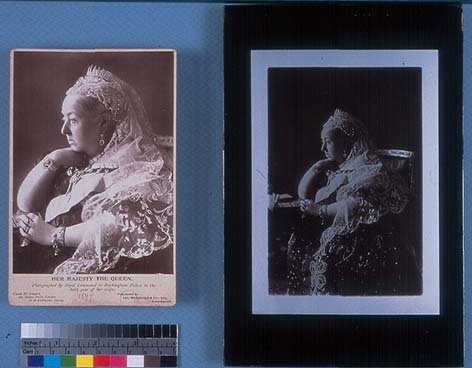
Fig. 12. Left cabinet card portrait, Right: metallic photographic print M-1
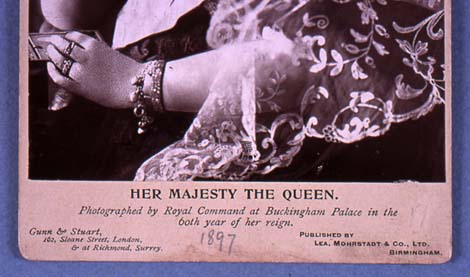
Fig. 13. Detail: printed caption on the mount of the cabinet card portrait of Her Majesty Queen Victoria. The pencil inscription noting the year, 1897, was written on the mount by Helmut Gernsheim
Another historical detail in the image is that she is wearing a mourning bracelet containing a portrait of her late husband, Prince Albert (fig. 14).
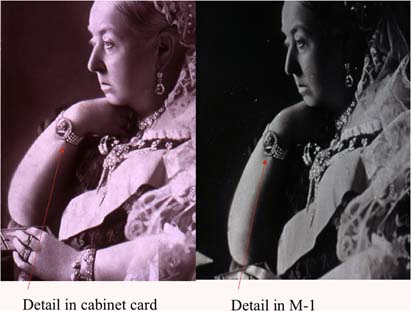
Fig. 14. Comparison of details, showing the mourning bracelet in both images
A feature of interest relating to the history of photography and photo-technology is that, on close inspection, one can see that she has her hand on a cased stereo photograph, probably a stereo daguerreotype and its viewing device, on the table in front of her (fig. 15). The albumen print on the cabinet card is more of a half-length portrait in its presentation and probably was trimmed some prior to mounting, so less of that part of the image is visible; however, it clearly visible in the image in M-1, which is more of a three-quarter length portrait.
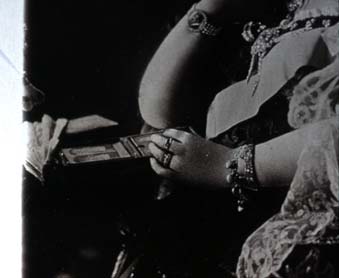
Fig. 15. Detail of M-1, showing what appears to be a stereo daguerreotype in its viewing case, on the table in front of the Queen
As seen in the XRF readings and locations on M-1 (fig. 16), no silver or other similar metal was detected on this metallic image. However, aluminum is among the lower atomic number elements on the Periodic Table of the Elements and would not register with any of the sources available to us in the XRF spectrometer.
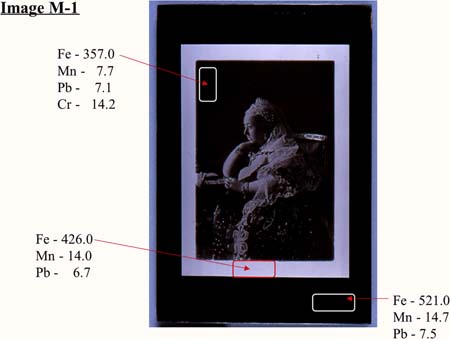
Fig. 16. M-1: The same elemental components appear in the readings in all image and non-image areas. No elements corresponding to a silver colored metal are indicated using XRF
Aluminum is considered to be a possible candidate for the metal used here, since the element had been discovered and first isolated only in 1845, and was considered a rare and expensive commodity until the late 1880s, thus it would have still have been held in considerable prestige at the time this portrait was made. (The metal was initially used for jewelry and other small precious objects, and Queen Victoria was among the first patrons of new jewelry fashioned from aluminum).9
The portrait of Queen Victoria initially looks similar to the other three metallic photographic prints, but closer examination of the surface characteristics of M-1, especially in raking light (fig. 17), show a surface relief and the presence of a dark image layer on top of the metallic layer, features that seem to indicate a variation on the procedure as described in the patent literature. Possibly this image was composed by placing a carbon print or transfer layer on top of an aluminum background. The pigment and metallic powder could not be identified without physical sampling (destructive testing), which has not been done at this time. However, based on visual inspection and the elemental analysis data, the following structure of the image has been deduced (fig. 18).
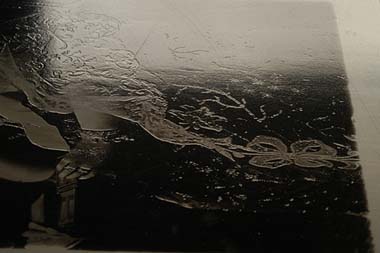
Fig. 17. Detail in raking light showing the surface relief on M-1
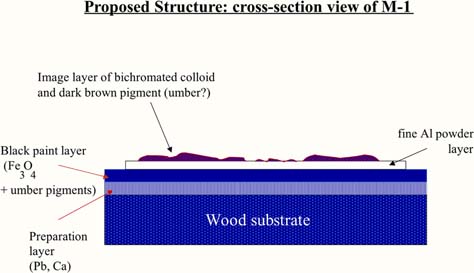
Fig. 18. Proposed structure cross-section of M-1 by D. Stulik. Graphics by B. Brown
The elemental analysis readings obtained via XRF, combined with the description of the process in the patent specification, and the observation that the three metallic portraits M-2, M-3, and M-4 all exhibited a similar smooth, glossy surface appearance in both normal and raking light, led to the diagram of the proposed structure in cross-sectional view shown below (fig. 19).
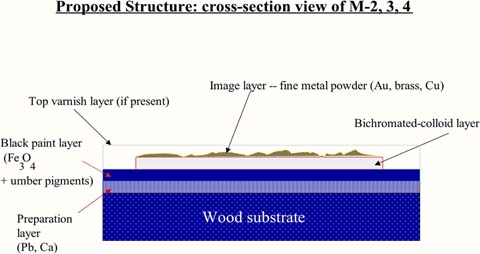
Fig. 19. Proposed structure cross-section of M-2, 3, 4 by D. Stulik. Graphics by B. Brown
In addition to XRF analysis, ATR-FTIR spectrometry analysis was conducted on these images. The FTIR/wavenumbers spectrum (fig. 20) indicates the presence of a coating composed of a proteinaceous material, gelatin in this instance. The presence of collodion is not indicated in this particular spectrum. (Information concerning the location and on which image this reading was taken was not available to the primary author at the time this paper was published).
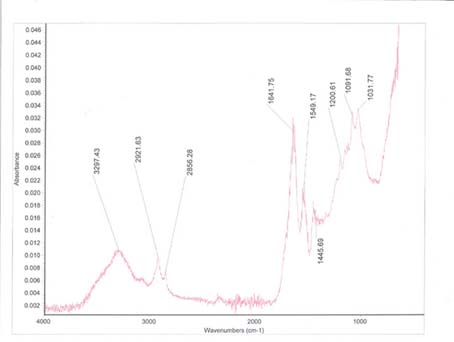
Fig. 20. ATR-FTIR spectrum of surface coating. By Herant Khanjian, Dusan Stulik
This project gave us the opportunity to study some objects that are outside the mainstream of photography, almost in the realm of ephemera – apparently rare, but rather charming and intriguing as artifacts and images. From the conservation standpoint, they appear to be fairly stable and well preserved. Enclosures will be constructed for these photographic prints to provide physical protection for them during storage and permit safe handling of the materials by researchers, to ensure the preservation of and access to these unique items. In studying these photographic prints, we are wondering if the process was used more than in just these four examples, and would like to hear from other individuals or institutions that might have similar items in their collections.
Very little if anything is known about the photographer and patent holder – Mr. Henry E. Fowler – so far, other than his name, location, and profession as stated in the beginning of the patent specifications. However, research into Gernsheim's notes and records, among other resources, continues. It is hoped that further information on the photographer as well as the sitters in the portraits, and this process, may be uncovered and presented in the future.
We extend out thanks and acknowledgements to our other colleagues at the Getty Conservation Institute – Gary Mattison and Tram Vo, and to Roger Taylor, Independent Researcher and Photohistorian, UK; and to our colleagues at the Harry Ransom Center: Roy Flukinger, Research Curator, Photography; David Coleman, Department Head and Associate Curator of Photography, Linda Briscoe Myers, Assistant Curator of Photography; and our colleagues in the HRC Conservation Department for their support. Thanks and appreciation to HRC Photographic Services staff, Pete Smith and Eric Beggs, for their assistance. Thanks also to Colin Ford, Founding Head of Britain's National Museum of Photography, Film & Television, for his interest and providing leads for further inquiry.
Photography and illustration credits: Figs. 1,2,7,8: Dusan Stulik. Figs. 3–5,6,13, 14: Barbara Brown. Figs. 9–11,16,18,19: concept – D. Stulik, photos and graphics – B. Brown. Figs. 12,15,17: Eric Beggs. Fig. 20: Herant Khanjian, D. Stulik.
Brown, Barbara. “Notes on a Preliminary Investigation into Bronze Powder Deterioration of Albumen Prints.” Topics in Photographic Preservation 1 (1986). pp. 2–4.
Gernsheim, Helmut. Inventory List #22, “Examples of Permanent Printing Processes & Photomechanical Processes”.
Nadeau, Luis. Encyclopedia of Printing, Photographic, and Photomechanical Processes: A Comprehensive Reference to Reproduction Technologies, Vol. 1. Fredericton, New Brunswick, Canada: Atelier Luis Nadeau, 1989; Encyclopedia of Printing, Photographic, and Photomechanical Processes: A Comprehensive Reference to Reproduction Technologies, Vol. 2. Fredericton, New Brunswick, Canada: Atelier Luis Nadeau, 1990.
Stulik, Dusan C. “Getty Conservation Institute portable analytical laboratory for photograph conservation: the first three years”; in the Preprints of the 14th Triennial Meeting of the ICOM Committee for Conservation, The Hague, The Netherlands, 12–16 September 2005, Vol. I. Forthcoming.
Patents for Inventions, Fifty Years Subject Index 1861-1910, Class 98 (ii) Photographic Processes and Apparatus other than for taking Photographs [including Photographic Plates, Films, and Papers]. London: Printed for His Majesty's Stationery Office, by Barclay & Fry, Ltd., Published at the Patent Office, 25, Southampton Buildings, Chancery Lane, 1914. p. 8.
Patents for Inventions. Abridgments of Specifications. Class 98, Photography. Period A.D. 1893-96. London: Printed for Her Majesty's Stationery Office, by Darling & Son, Ltd., Published at the Patent Office, 25 Southampton Buildings, Chancery Lane, 1899. p. 153.
Getty Conservation Institute, Conservation Science Current Projects, “Research on the Conservation of Photographs,” J. Paul Getty Trust. http://www.getty.edu/conservation/science/photocon/index.html
Harry Ransom Humanities Research Center at The University of Texas at Austin, Photography Collection, “Holdings”, http://www.hrc.utexas.edu/collections/photography/holdings/.
Conservation and Art Material Encyclopedia Online (CAMEO), Museum of Fine Arts, Boston. “Burnt umber”, Michele R. Derrick, copyright 2005. Conservation and Collections Management Department at the Museum of Fine Arts, Boston. http://www.mfa.org/_cameo/frontend/material_results.asp?MaterialName=umber.
“Aluminum By Design: Jewelry to Jets,” Cooper-Hewitt, National Design Museum of the Smithsonian Institution. http://ndm.si.edu/alum/home.html.
1 Getty Conservation Institute, Conservation Science Current Projects, “Conservation of Photographs,” http://www.getty.edu/conservation/science/photocon/index.html.
2 Ibid.
3 Harry Ransom Humanities Research Center at The University of Texas at Austin, Photography Collection, “Holdings”, http://www.hrc.utexas.edu/collections/photography/holdings/.
4 Patent No. 14,077.—A.D.1896. On page 1, Provisional Specification, the following information is printed below the patent number and year: Date of Application, 25th June, 1896 Complete Specification Left, 24th Mar., 1897 –Accepted, 12th June 1897. On the following page (2), an additional title appears above the Complete Specification, and below the patent number and year: Fowler's Process for Producing Photographs in Gold, &c., on Polished Surfaces.
5 Patent No. 14,077.—A.D.1896. On page 1, Provisional Specification, the following information is printed below the patent number and year: Date of Application, 25th June, 1896 Complete Specification Left, 24th Mar., 1897 –Accepted, 12th June 1897. On the following page (2), an additional title appears above the Complete Specification, and below the patent number and year: Fowler's Process for Producing Photographs in Gold, &c., on Polished Surfaces. (from page 2, Complete Specification).
6 Conservation and Art Material Encyclopedia Online (CAMEO), Museum of Fine Arts, Boston. “Burnt umber”, Michele R. Derrick, copyright 2005. http://www.mfa.org/_cameo/frontend/material_results.asp?MaterialName=umber
7 Brown, B. “Notes on a Preliminary Investigation into Bronze Powder Deterioration of Albumen Prints.” Topics in Photographic Preservation, Vol. 1, p. 2.
8 It is possible that the portrait of Miss Mabel Love, as identified in M-3, is one that was taken in the earlier years of the actress and dancer Mabel Love, of whom a number of photographic portraits, taken in the 1910s, are apparently located in the collection of the National Portrait Gallery, London. [The lead to the NPG collection was provided by Colin Ford, former curator of photography at the NPG and former director of the National Museum of Photography, Film and Television, Bradford, UK. Private correspondence.] Further research on this is necessary to confirm whether the images are of the same person.
9 The possibility of aluminum being the metal powder is one to consider since, in the 1890s, it was just becoming more readily available – having been first discovered or isolated only 1845, and presented to the public in 1855 at the Paris World's Fair, it was a rare and expensive commodity since it's extraction from ore was so difficult. Not until the late 1880s did chemists working independently in the U.S. and France discover an electrolytic process for extracting aluminum, which allowed to be produced in industrial quantities. (“Aluminum By Design: Jewelry to Jets”, exhibit organized by the Carnegie Museum of Art, Pittsburgh and on view at the Smithsonian, Cooper-Hewitt, National Design Museum during March 20-July 15, 2001. See online text at: http://ndm.si.edu/alum/home.html.)
BARBARA N. BROWN, Conservator of Photographs, Harry Ransom Center, University of Texas at Austin, Austin, TX(presenter)
DUSAN C. STULIK, Senior Scientist and HERANT KHANJIAN, Assistant Scientist, Getty Conservation Institute, Los Angeles, CA
Papers presented in Topics in Photographic Preservation, Volume Eleven, have not undergone a formal process of peer review.